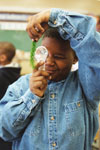Join us for conversations that inspire, recognize, and encourage innovation and best practices in the education profession.
Available on Apple Podcasts, Spotify, Google Podcasts, and more.

Boy with
“green stuff”
During this session, you will have an opportunity to build understandings to help you:
What is life? This question at first seems deceptively simple—we all know how to recognize what is living and what is not. Or do we? What are the characteristics of all living things, and how do we know if an object really possesses those characteristics? This session explores how the concept “life” can be defined.
We open with a look at environments where you wouldn’t expect to find life and pose this question: “If you are looking for life, what do you look for?” Dr. Herbert Thier, representing the Science Curriculum Improvement Study (SCIS 3+), emphasizes the importance of building understandings of the concept “life” in the early elementary grades as a foundation for the development of ideas in life science throughout the elementary school years and beyond.
The program continues as children in grades two and three are presented with a challenge: group objects as living, dead, or nonliving. In what is called the “Science Studio,” the children are observed and interviewed in a clinical setting to uncover their ideas about these three concepts. Throughout the course, the Science Studio is a place where research on children’s ideas is brought to life.
In Brooklyn, New York, we visit LauraJo Kelly and her second-grade students as they generate their own definitions of living, dead, and nonliving and proceed to design experiments to test whether a “mysterious” object is alive. An interview with Dr. Gary Ruvkun, who is leading a team of researchers to determine whether life exists on Mars, tells us what he considers to be the best sign of life.
Our search for an answer to the question “What is life?” leads us to consider five characteristics that are shared by all living things. One characteristic—cells —introduces us to the fundamental unit of life. We also look more closely at the matter that composes life and see the role played by organic molecules, such as the hereditary molecule DNA.
Finally, Dr. Paul Williams introduces us to an ongoing Web site-based activity—Bottle Biology—that is meant to provide you with an opportunity to apply ideas addressed during this session as well as act as a resource for K-6 classroom activities.